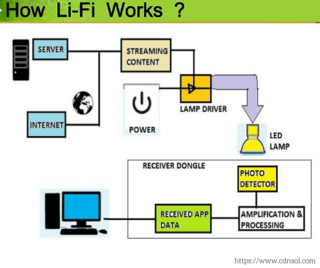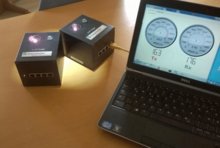IEEE 802.15 is a working group of the Institute of Electrical and Electronics Engineers (IEEE) IEEE 802 standards committee which specifies Wireless Specialty Networks (WSN) standards. The working group was formerly known as Working Group for Wireless Personal Area Networks.

IEEE 802.11 is part of the IEEE 802 set of local area network (LAN) technical standards, and specifies the set of medium access control (MAC) and physical layer (PHY) protocols for implementing wireless local area network (WLAN) computer communication. The standard and amendments provide the basis for wireless network products using the Wi-Fi brand and are the world's most widely used wireless computer networking standards. IEEE 802.11 is used in most home and office networks to allow laptops, printers, smartphones, and other devices to communicate with each other and access the Internet without connecting wires. IEEE 802.11 is also a basis for vehicle-based communication networks with IEEE 802.11p.

A wireless network is a computer network that uses wireless data connections between network nodes. Wireless networking allows homes, telecommunications networks and business installations to avoid the costly process of introducing cables into a building, or as a connection between various equipment locations. Admin telecommunications networks are generally implemented and administered using radio communication. This implementation takes place at the physical level (layer) of the OSI model network structure.

Wi-Fi is a family of wireless network protocols based on the IEEE 802.11 family of standards, which are commonly used for local area networking of devices and Internet access, allowing nearby digital devices to exchange data by radio waves. These are the most widely used computer networks, used globally in home and small office networks to link devices and to provide Internet access with wireless routers and wireless access points in public places such as coffee shops, hotels, libraries, and airports to provide visitors.

Free-space optical communication (FSO) is an optical communication technology that uses light propagating in free space to wirelessly transmit data for telecommunications or computer networking. "Free space" means air, outer space, vacuum, or something similar. This contrasts with using solids such as optical fiber cable.

The Infrared Data Association (IrDA) is an industry-driven interest group that was founded in 1994 by around 50 companies. IrDA provides specifications for a complete set of protocols for wireless infrared communications, and the name "IrDA" also refers to that set of protocols. The main reason for using the IrDA protocols had been wireless data transfer over the "last one meter" using point-and-shoot principles. Thus, it has been implemented in portable devices such as mobile telephones, laptops, cameras, printers, and medical devices. The main characteristics of this kind of wireless optical communication are physically secure data transfer, line-of-sight (LOS) and very low bit error rate (BER) that makes it very efficient.
In the seven-layer OSI model of computer networking, the physical layer or layer 1 is the first and lowest layer: the layer most closely associated with the physical connection between devices. The physical layer provides an electrical, mechanical, and procedural interface to the transmission medium. The shapes and properties of the electrical connectors, the frequencies to transmit on, the line code to use and similar low-level parameters, are specified by the physical layer.

Wireless communication is the transfer of information (telecommunication) between two or more points without the use of an electrical conductor, optical fiber or other continuous guided medium for the transfer. The most common wireless technologies use radio waves. With radio waves, intended distances can be short, such as a few meters for Bluetooth or as far as millions of kilometers for deep-space radio communications. It encompasses various types of fixed, mobile, and portable applications, including two-way radios, cellular telephones, personal digital assistants (PDAs), and wireless networking. Other examples of applications of radio wireless technology include GPS units, garage door openers, wireless computer mouse, keyboards and headsets, headphones, radio receivers, satellite television, broadcast television and cordless telephones. Somewhat less common methods of achieving wireless communications involve other electromagnetic phenomena, such as light and magnetic or electric fields, or the use of sound.

In telecommunications, visible light communication (VLC) is the use of visible light as a transmission medium. VLC is a subset of optical wireless communications technologies.

A home network or home area network (HAN) is a type of computer network that facilitates communication among devices within the close vicinity of a home. Devices capable of participating in this network, for example, smart devices such as network printers and handheld mobile computers, often gain enhanced emergent capabilities through their ability to interact. These additional capabilities can be used to increase the quality of life inside the home in a variety of ways, such as automation of repetitive tasks, increased personal productivity, enhanced home security, and easier access to entertainment.
LVX System of Companies is the inventor of Visible Light Communication and Light Fidelity market. The LVX system is a collection of LED light bulbs and specialized equipment which allow the transmission of data through light photons- pulse width modulation (PWM) of the LED. The current speed at which the data is able to be transmitted is 3 Mbit/s. The goal of the LVX system is to free up wireless Wi-Fi spectrum which LVX asserts can be quite congested in some business areas. The 3 Mbit/s speed is slower than existing Wi-Fi technology, but the company is working on an improved LED which will be able to match the speeds of current Wi-Fi networks. The lights also have ability to transmit any specific colour along the spectrum. Because the lights are also communication devices, they could be directed through the LVX network to turn a certain colour to lead the way out of a building during emergencies or to a specific office. As well, lights could be directed to turn on and off as an energy savings measure. The communication and networking capabilities are marketed as an add-on or "bonus" to the energy savings and maintenance inherited by LED lights in general as compared to fluorescent or incandescent light bulbs. LVX sells maintenance contracts in which LVX will be responsible for the 24/7 maintenance of the lights.
IEEE 802.11b-1999 or 802.11b is an amendment to the IEEE 802.11 wireless networking specification that extends throughout up to 11 Mbit/s using the same 2.4 GHz band. A related amendment was incorporated into the IEEE 802.11-2007 standard.
IEEE 802.11g-2003 or 802.11g is an amendment to the IEEE 802.11 specification that operates in the 2.4 GHz microwave band. The standard has extended link rate to up to 54 Mbit/s using the same 20 MHz bandwidth as 802.11b uses to achieve 11 Mbit/s. This specification, under the marketing name of Wi‑Fi, has been implemented all over the world. The 802.11g protocol is now Clause 19 of the published IEEE 802.11-2007 standard, and Clause 19 of the published IEEE 802.11-2012 standard.
Gigabit Home Networking (G.hn) is a specification for wired home networking that supports speeds up to 2 Gbit/s and operates over four types of legacy wires: telephone wiring, coaxial cables, power lines and plastic optical fiber. Some benefits of a multi-wire standard are lower equipment development costs and lower deployment costs for service providers.

John O'Sullivan is an Australian engineer.
The Li-Fi Consortium is an international organization focusing on optical wireless technologies. It was founded by four technology-based organizations in October 2011. The goal of the Li-Fi Consortium is to foster the development and distribution of (Li-Fi) optical wireless technologies such as communication, navigation, natural user interfaces and others.
Optical wireless communications (OWC) is a form of optical communication in which unguided visible, infrared (IR), or ultraviolet (UV) light is used to carry a signal. It is generally used in short-range communication.
Wi-Fi 6, or IEEE 802.11ax, is an IEEE standard from the Wi-Fi Alliance, for wireless networks (WLANs). It operates in the 2.4 GHz and 5 GHz bands, with an extended version, Wi-Fi 6E, that adds the 6 GHz band. It is an upgrade from Wi-Fi 5 (802.11ac), with improvements for better performance in crowded places. Wi-Fi 6 covers frequencies in license-exempt bands between 1 and 7.125 GHz, including the commonly used 2.4 GHz and 5 GHz, as well as the broader 6 GHz band.
WiFi sensing uses existing Wi-Fi signals to detect events or changes such as motion, gesture recognition, and biometric measurement. WiFi sensing is a combination of Wi-Fi and radar sensing technology working in tandem to enable usage of the same Wi-Fi transceiver hardware and RF spectrum for both communication and sensing.

IEEE802.11bb is a line-of-sight light-based wireless networking standard that is part of the 802.11 suite of standards, which defines an interoperable communications protocol for Li-Fi devices. Its proponents state that it will allow for very high speed communication that is faster than Wi-Fi.











